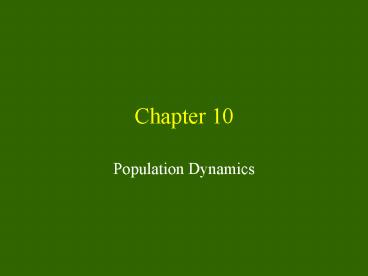Population Dynamics PowerPoint PPT Presentation
Title: Population Dynamics
1
Chapter 10
- Population Dynamics
2
Life Tables and Survivorship Curves
Life Tables provide data on age cohorts, number
of survivors, number of deaths, and also
reproductive information Survivorship Curves
indicate the number of surviving individuals over
time
3
Constant Survival Rates
Some populations exhibit consistent rates of
mortality through the age of the cohort
4
High Early Mortality
Other populations suffer high mortality of young
individuals, while a few survive to old age
5
Deevey Survivorship Curves
Type I High old-age mortality Type II Constant
mortality Type III High juvenile mortality
6
Regenerating Age Structure
Age structures show the abundance of individuals
at different ages in the population
7
Non-Regenerating Age Structure
Some populations do not show evidence of
regeneration
8
Varying Age Structures
Some populations exhibit bursts of regeneration
as well as time-periods of low regeneration
9
Phlox drummondii Life Table
A population that is increasing in size Ro net
reproductive rate
10
Geometric Rate of Increase
A rate of change indicating consistent growth (?)
11
Mud Turtle Life Table
A population that is decreasing in size Ro S
lxmx 0.601 Sxlxmx 6.4 T (Sxlxmx)/Ro
10.6 average generation time
12
Generation Times
Generation time is correlated with body
size Why?..
13
Per Capita Rate of Increase
- The rate of increase in population size relative
to the size of the population - r (ln Ro) / T
14
Dispersal Range Expansion
As populations grow in size, they seek more area
in which to live Why?.
15
Rates of Expansion
Some populations expand at different rates than
others Why?. What does this difference
indicate about the ecological impacts of some
species?.
16
Dispersal and Climate Change
As climates change, distributions change, and
populations disperse
17
Dispersal and Food Supply
Populations may disperse to follow a food supply
even if their population size does not change
18
Summary
- Survivorship Curves
- Age Distributions
- Life Tables Ro, ?, T, r
- Dispersal
PowerShow.com is a leading presentation sharing website. It has millions of presentations already uploaded and available with 1,000s more being uploaded by its users every day. Whatever your area of interest, here you’ll be able to find and view presentations you’ll love and possibly download. And, best of all, it is completely free and easy to use.
You might even have a presentation you’d like to share with others. If so, just upload it to PowerShow.com. We’ll convert it to an HTML5 slideshow that includes all the media types you’ve already added: audio, video, music, pictures, animations and transition effects. Then you can share it with your target audience as well as PowerShow.com’s millions of monthly visitors. And, again, it’s all free.
About the Developers
PowerShow.com is brought to you by CrystalGraphics, the award-winning developer and market-leading publisher of rich-media enhancement products for presentations. Our product offerings include millions of PowerPoint templates, diagrams, animated 3D characters and more.

